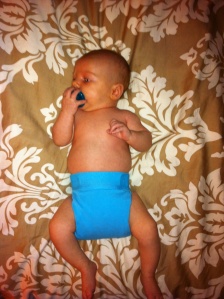A quick note about co-sleeping and safety September 6, 2011
Posted by sleepdoctorevans in baby, co-sleeping, sleep education, sleep environment.Tags: baby, co-sleeping, infant, parenting, sleep, sleep education, sleep environment
trackback
I’ve had many questions about why we chose to co-sleep with Teague and I feel that I should clarify why we decided to do that. When Graham was born, I did not want to co-sleep, but I fell asleep so often in a chair with him in my arms after I fed him that I realized it was actually probably safer to have him co-sleeping. I would say that we were “reactionary” co-sleepers with Graham.
 Many parents become accidental co-sleepers, because frankly if you are breastfeeding it’s often just easier. When your baby is right next to you in a co-sleeper, you can just pull him/her up to you at wakings and often neither parent nor child has a full waking. When you have a baby in a separate room or in a separate sleep space, it can accelerate your sleep debt, because you usually don’t hear your child until s/he is fully awake and then you have to get out of bed and wake yourself fully. This pattern of intermittent waking is exhausting for some people (including me!). I decided to co-sleep with Teague, based on my experience with Graham. I felt that making the decision to co-sleep from the very beginning would make me feel a bit more like I was in control of the co-sleeping rather than feeling that I was resigning to co-sleeping. I definitely do not plan to co-sleep with Teague longer than the first few months and as he needs fewer feedings at night, I plan to transition him to sleeping in his bassinet (or crib) full time. I can handle getting up once a night, but I can’t handle getting up 3-5 times a night.
Many parents become accidental co-sleepers, because frankly if you are breastfeeding it’s often just easier. When your baby is right next to you in a co-sleeper, you can just pull him/her up to you at wakings and often neither parent nor child has a full waking. When you have a baby in a separate room or in a separate sleep space, it can accelerate your sleep debt, because you usually don’t hear your child until s/he is fully awake and then you have to get out of bed and wake yourself fully. This pattern of intermittent waking is exhausting for some people (including me!). I decided to co-sleep with Teague, based on my experience with Graham. I felt that making the decision to co-sleep from the very beginning would make me feel a bit more like I was in control of the co-sleeping rather than feeling that I was resigning to co-sleeping. I definitely do not plan to co-sleep with Teague longer than the first few months and as he needs fewer feedings at night, I plan to transition him to sleeping in his bassinet (or crib) full time. I can handle getting up once a night, but I can’t handle getting up 3-5 times a night.
If you choose to co-sleep you need to do it safely. The American Academy of Pediatrics DOES NOT advise co-sleeping due to the risk of entrapment and the increased risk of SIDS associated with co-sleeping. These are serious risks. I don’t like to be a product pusher, but a sidecar co-sleeper like the Arm’s Reach Co-sleeper allows your child to sleep with you, but in a separate, safe space. Your baby should not have pillows or blankets in his/her sleep space and you should ensure that there are no gaps between your mattress and the co-sleeping mattress. In addition, you should make sure that your partner knows whenever your baby is in bed and you must not co-sleep if you’ve taken any medication, drugs or alcohol. Learn more about safe sleeping guidelines here: http://www.aap.org/healthtopics/sleep.cfm
There is nothing wrong with having your baby sleep in a dedicated nursery. I would probably consider having Teague sleep in his own room if we had a separate room for him, but we don’t. I actually tried to fit the crib in one of our bathrooms, but our bathrooms are tiny and it didn’t fit. The advantage to having a baby in a separate sleep space is that you won’t wake to every little noise your baby makes. Babies are noisy sleepers and some moms will instinctively just start to nurse in response to every squeak and grunt. It can be really hard to tell if your baby is really asking to be fed versus if s/he is still asleep, but just making a lot of noise. Responding to every noise can cause a pattern of all night nursing in some babies which can be a big drawback to co-sleeping.
So, how do you make decisions? You obviously need to do what you feel makes the most sense for your family circumstances. If you are co-sleeping and fear having an all night nurser, try to give yourself some loose rules to follow. For example, if your baby ate one hour ago s/he probably doesn’t need to eat again, so you can feel ok listening to see if your baby is truly waking up or if s/he is just making a lot of noise in his/her sleep. You might be surprised that your baby gets quiet after a brief period and continues sleeping.
Comments»
No comments yet — be the first.